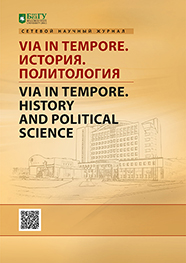PALESTINIAN MONASTERY, ITS ROLE IN THEOLOGIAN DISPUTES IN IV–VII CENTURIES
DOI:
https://doi.org/10.18413/2687-0967-2020-47-2-269-273Keywords:
Origen, Palestine, monasticism, monastery, laurel, Origenism, fallacies, condemnationAbstract
The origin of monasticism in Byzantium is associated with the era of Constantine the Great. The reasons for the growth of monasticism was the fact that in the state under Constantine, Christianity ceased to be a persecuted religion. Therefore, from the 4th century, monasticism begins its dawn. A lot of people become involved in the monastic movement, and the Christian Church, as an organization and public institution, creates charters of life for monastic. Monks and monasteries were completely controlled by church authorities. The Monks and monasteries were completely controlled by church authorities. Throughout the entire history of the Byzantine Empire, monasticism occupied an important place not only in the spiritual life of the state, but in its political, economic, and social life. With the participation in theological disputes, Byzantine monasticism also took an active part. One such confrontation was the Origen dispute. After the death, the founder of the Great Lavra, Savva the Consecrated, the Origenists openly began to spread their teachings first within the walls of their monastery, and then in other monasteries. As a result, after the condemnation of Origenism at the V Ecumenical Council, monks who did not recognize its decisions were expelled, which led to the decline of monasticism in Palestine.
Downloads
References
Беляев Д.А. 1903. Православная богословская энциклопедия. Том 4. Петроград. http://www.biblioteka3.ru.html.
Болотов В.В. 2006. Лекции по истории Древней Церкви. Санкт-Петербург, Аксион Эстин. Т. 1, 234.
Бриллиантов А.И. 2014. Лекции по истории древней церкви. М., Директ-Медиа, 440.
Войтенко А.А. 2012. Египетское монашество в IV веке: Житие преп. Антония Велико-го, Лавсаик, История монахов. М., ЦЕИ РАН, 318.
Древние иноческие уставы. Пахомия Великого, Василия Великого, Иоанна Касианина, Венедикта. 1892. М., Типография И. Ефимова, Большая Якиманка, 664.
Житие св. Саввы Освященного, составленное св. Кириллом Скифопольским. 1890. СПб, Изд. И. Помяловский, 588.
Курэ А. 1894. Палестина под властью христианских императоров. СПб., Русский па-ломник, 635.
Муравьев А.Н. 1851. Письма с Востока. СПб., Типография III И.Е.В. канцелярии. В 2 т.
Муравьев А.Н. 1844. История святого града Иерусалима. СПб., Типография III И.Е.В. канцелярии, 804.
Норов А.С. 1839. Путешествие по Святой Земле. СПб., [б.и.], 167.
Панченко К.А. 2007. Монастыри и бедуины в Османской Империи и на Синае (XVI – первая половина XIX в.). Вестник ПСТГУ. Серия 3: Филология. № 7: 68–98.
Поснов М.Э. 1991. История Христианской Церкви. Киев, Ч. 1.
Преподобный Антоний Великий. 2010. Житие и послания. М., ООО «Синтагма», 256.
Руфина пресвитера. 1898. Жизнь пустынных отцев. Сергиев Посад, Свято-Троицкая Сергиева лавра, 120.
Симонопетрский М. 2011. Синаксарь: Жития святых Православной Церкви в 6 т. М., Изд-во Сретенского монастыря, 511.
Сладкопевцев П.М. 1896. Древние палестинские обители и прославившие их святые подвижники. СПб., Сибирская Благозвонница, 340.
Творения Оригена, учителя александрийского. 1899. Казань, Изд-во Казанской духов-ной академии, 385.
Brief History of the Holy Laura of Saint Sabbas. - https://www.impantokratoros.gr/B4A11589.en.aspx
Guthe. 1880. Zeitschrift des Deutschen Palastina-Vereins. Bd. 3. 250.
Kyrillos von Skythopolis. 1939. Vita Euthymii. Ed. E. Schwartz. Lpz., Teubner, 300.
Ramsay W.M. 2004. The church of the Roman Empire before A. D. 170. Kessinger Publish-ing, 548.
Schwartz R.N. 1998. The Roman Empire: a concise history of the first two centuries. Uni-versity Press of America, 194.
Abstract views: 842
Share
Published
How to Cite
Issue
Section
Copyright (c) 2020 Via in tempore. History and political science

This work is licensed under a Creative Commons Attribution 4.0 International License.


